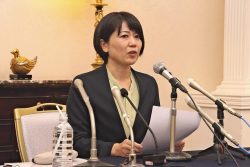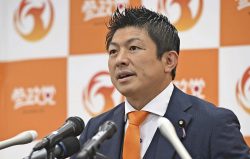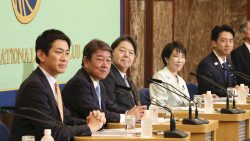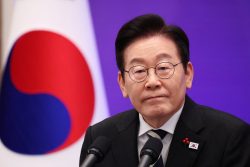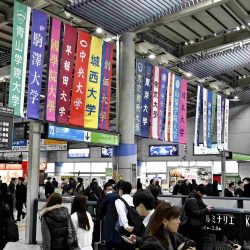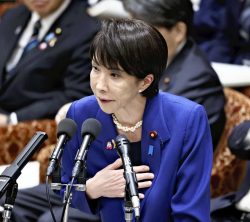Official Campaigning Kicks Off for Japan’s House of Representatives Election; Party Leaders Hit Campaign Trail

From left: Liberal Democratic Party President Shigeru Ishiba, Constitutional Democratic Party of Japan President Yoshihiko Noda, Japan Innovation Party leader Nobuyuki Baba, Komeito leader Keiichi Ishii, Japanese Communist Party leader Tomoko Tamura and Democratic Party for the People leader Yuichiro Tamaki. All photos were taken on Tuesday.
20:00 JST, October 15, 2024
Campaigning for the 50th House of Representatives election officially kicked off Tuesday, with candidates vying to secure votes over 12 days through Oct. 27, when voting and ballot counting will take place.
The ruling coalition of the Liberal Democratic Party and Komeito will face off against opposition parties such as the Constitutional Democratic Party of Japan and the Japan Innovation Party. Economic measures, including ones for combating high prices, and political reform in response to the scandal of political funds involving LDP factions are some of the key issues on the agenda.
All 465 seats in the lower house will be up for grabs in the election. Of them, 289 will be elected in single-seat constituencies and 176 through proportional representation segments. The number of seats required for a majority is 233.
According to a tally by The Yomiuri Shimbun as of 1:20 p.m. on Tuesday, a total of 1,265 candidates registered to run in the race. The number greatly exceeds the 1,051 candidates in the 2021 lower house election.
Party leaders hit the campaign trail on Tuesday morning.
Prime Minister Shigeru Ishiba, who is also LDP president, stumped in Iwaki, Fukushima Prefecture. “I will face this election while deeply reflecting on the issue of politics and money so that it will never happen again,” he said on the topic of the political funds scandal involving LDP factions.
Ishiba added: “It is the LDP-Komeito government that can protect Japan’s peace and independence. We will create new economic measures for Japan with reconstruction at its core.”
In front of JR Hachioji Station in Tokyo, CDPJ leader Yoshihiko Noda emphasized that he would visit the constituencies of big-name LDP politicians who had amassed hidden funds on the day of the official start of campaigning, in order to make the public understand that the issue of hidden funds is a major point of contention and show they share their anger.
“Prime Minister Ishiba may have dissolved the lower house to hide the issue of hidden funds out of fear that his Cabinet’s approval ratings would fall,” Noda said.
JIP leader Nobuyuki Baba said in front of JR Takadanobaba Station in Tokyo: “In order to regain trust in politics, more self-sacrificial reforms are needed. We will implement policies that will lead to higher wages.”
In front of JR Ikebukuro Station in Tokyo, Komeito leader Keiichi Ishii said: “Policies must be implemented that continue to raise wages more than the pace of the rise in prices. It is only the LDP-Komeito coalition government that can advance such policies.”
Japanese Communist Party Chairperson Tomoko Tamura, also in front of JR Ikebukuro Station, stressed that “the growth of the JCP will be the power that wipes out the issue of hidden funds and corruption.”
Yuichiro Tamaki, the leader of the Democratic Party for the People in Kobe said, “We will fight throughout the election campaign on a platform of economic policies that will increase the take-home pay of the people.”
Other party leaders, including those of Reiwa Shinsengumi, the Social Democratic Party and Sanseito, also made stump speeches. Reiwa announced on Tuesday that party leader Taro Yamamoto had been hospitalized in an emergency.
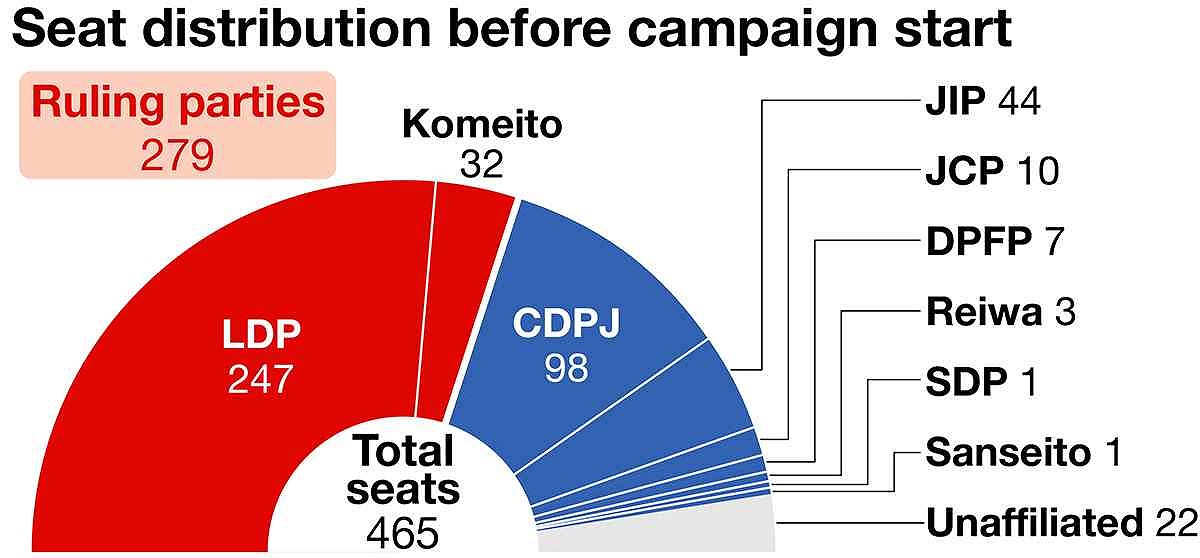
In this lower house election, the LDP leadership did not endorse some former Diet members and others to run as official party candidates, or to allow them to run in the proportional representation segment as well as in a single-seat constituency, due to their involvement in the political funds scandal.
The results of the 44 single-seat constituencies, in which these members are running, may hold the key to victory or defeat in the election as a whole.
Ishiba has indicated that the LDP will grant official candidate status to those who win as independent candidates.
Ishiba has indicated that the LDP and Komeito together securing a majority of seats will be the baseline for a victory. The focus is also on whether the LDP alone can maintain a majority. The CDPJ and other parties are calling for a change of government, with the goal of removing the ruling coalition’s majority in the lower house.
The time frame between the inauguration of the Cabinet and the lower house election will be just 26 days, the shortest in the postwar era.
"Politics" POPULAR ARTICLE
-

Japan to Support Central Asian Logistics Route That Bypasses Russia, Plan to Be Part of Upcoming Summit in Tokyo
-

Japan to Tighten Screening of Foreigners’ Residential Status by Providing Information of Nonpayment of Taxes
-

Chinese, Russian Bombers Flew Unusual Path by Heading Toward Tokyo; Move Likely Meant to Intimidate Japan
-
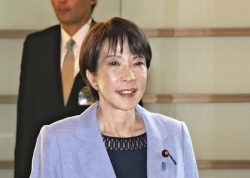
Japan Plans National Database to Track Foreign Ownership of Real Estate, Land as It Weighs New Rules
-

Up to 199,000 Deaths Estimated From Mega-Tsunami; Most Recent Occurrence Took Place in 17th Century
JN ACCESS RANKING
-

Tokyo Economic Security Forum to Hold Inaugural Meeting Amid Tense Global Environment
-

Keidanren Chairman Yoshinobu Tsutsui Visits Kashiwazaki-Kariwa Nuclear Power Plant; Inspects New Emergency Safety System
-

Imports of Rare Earths from China Facing Delays, May Be Caused by Deterioration of Japan-China Relations
-

University of Tokyo Professor Discusses Japanese Economic Security in Interview Ahead of Forum
-

Japan Pulls out of Vietnam Nuclear Project, Complicating Hanoi’s Power Plans


